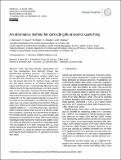Files in this item
An alternative method for correcting fluorescence quenching
Item metadata
| dc.contributor.author | Biermann, Lauren | |
| dc.contributor.author | Guinet, Christophe | |
| dc.contributor.author | Bester, Marthan | |
| dc.contributor.author | Brierley, Andrew Stuart | |
| dc.contributor.author | Boehme, Lars | |
| dc.date.accessioned | 2014-07-21T11:01:04Z | |
| dc.date.available | 2014-07-21T11:01:04Z | |
| dc.date.issued | 2015-01-13 | |
| dc.identifier.citation | Biermann , L , Guinet , C , Bester , M , Brierley , A S & Boehme , L 2015 , ' An alternative method for correcting fluorescence quenching ' , Ocean Science , vol. 11 , no. 1 , pp. 83-91 . https://doi.org/10.5194/os-11-83-2015 | en |
| dc.identifier.issn | 1812-0784 | |
| dc.identifier.other | PURE: 126140108 | |
| dc.identifier.other | PURE UUID: 91d48292-2076-4960-bcfe-7d14ea94c76e | |
| dc.identifier.other | Scopus: 84920995429 | |
| dc.identifier.other | ORCID: /0000-0002-6438-6892/work/60427315 | |
| dc.identifier.other | WOS: 000350556600006 | |
| dc.identifier.uri | https://hdl.handle.net/10023/5042 | |
| dc.description | This work received funding from the MASTS pooling initiative (The Marine Alliance for Science and Technology for Scotland) and their support is gratefully acknowledged. MASTS is funded by the Scottish Funding Council (grant reference HR09011) and contributing institutions. | en |
| dc.description.abstract | Under high light intensity, phytoplankton protect their photosystems from bleaching through non-photochemical quenching processes. The consequence of this is suppression of fluorescence emission, which must be corrected when measuring in situ yield with fluorometers. We present data from the Southern Ocean, collected over five austral summers by 19 southern elephant seals tagged with fluorometers. Conventionally, fluorescence data collected during the day (quenched) were corrected using the limit of the mixed layer, assuming that phytoplankton are uniformly mixed from the surface to this depth. However, distinct deep fluorescence maxima were measured in approximately 30% of the night (unquenched) data. To account for the evidence that chlorophyll is not uniformly mixed in the upper layer, we propose correcting from the limit of the euphotic zone, defined as the depth at which photosynthetically available radiation is ~ 1% of the surface value. Mixed layer depth exceeded euphotic depth over 80% of the time. Under these conditions, quenching was corrected from the depth of the remotely derived euphotic zone Zeu, and compared with fluorescence corrected from the depth of the density-derived mixed layer. Deep fluorescence maxima were evident in only 10% of the day data when correcting from mixed layer depth. This was doubled to 21% when correcting from Zeu, more closely matching the unquenched (night) data. Furthermore, correcting from Zeu served to conserve non-uniform chlorophyll features found between the 1% light level and mixed layer depth. | |
| dc.format.extent | 9 | |
| dc.language.iso | eng | |
| dc.relation.ispartof | Ocean Science | en |
| dc.rights | © Author(s) 2015. This work is distributed under the Creative Commons Attribution 3.0 License | en |
| dc.subject | QK Botany | en |
| dc.subject | GC Oceanography | en |
| dc.subject | NDAS | en |
| dc.subject.lcc | QK | en |
| dc.subject.lcc | GC | en |
| dc.title | An alternative method for correcting fluorescence quenching | en |
| dc.type | Journal article | en |
| dc.contributor.sponsor | NERC | en |
| dc.contributor.sponsor | NERC | en |
| dc.description.version | Publisher PDF | en |
| dc.description.version | Publisher PDF | en |
| dc.contributor.institution | University of St Andrews. School of Biology | en |
| dc.contributor.institution | University of St Andrews. Marine Alliance for Science & Technology Scotland | en |
| dc.contributor.institution | University of St Andrews. Sea Mammal Research Unit | en |
| dc.contributor.institution | University of St Andrews. Scottish Oceans Institute | en |
| dc.contributor.institution | University of St Andrews. Centre for Research into Ecological & Environmental Modelling | en |
| dc.contributor.institution | University of St Andrews. Pelagic Ecology Research Group | en |
| dc.identifier.doi | https://doi.org/10.5194/os-11-83-2015 | |
| dc.description.status | Peer reviewed | en |
| dc.identifier.grantnumber | NE/E018289/1 | en |
| dc.identifier.grantnumber | NE/G014833/1 | en |
This item appears in the following Collection(s)
Items in the St Andrews Research Repository are protected by copyright, with all rights reserved, unless otherwise indicated.


